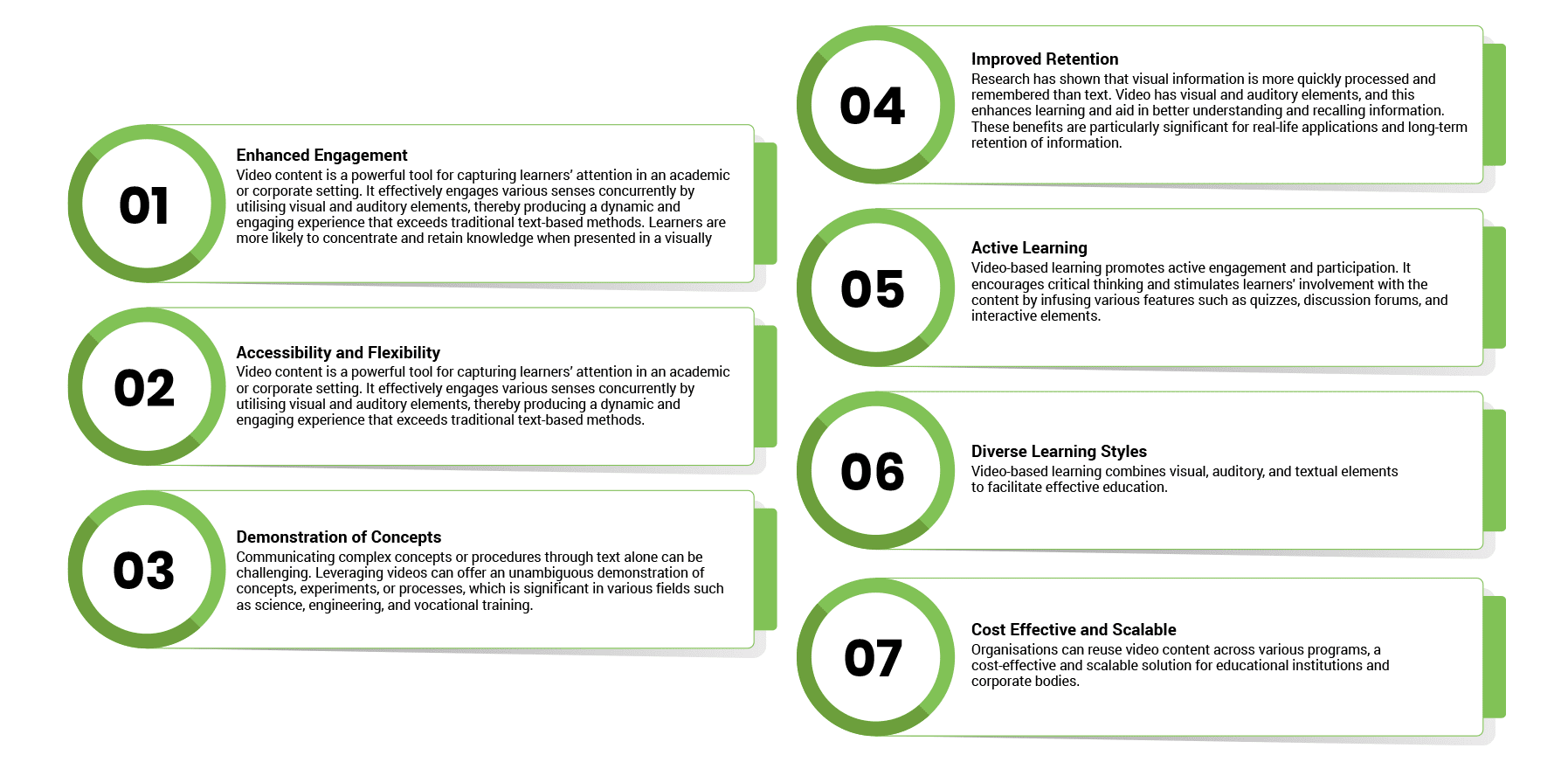Imagine a world where learning isn’t confined to textbooks and lectures but comes alive through the vibrant lens of videos. Picture a student, not just passively absorbing information but emotionally connecting with the subject matter, feeling its heartbeat through the screen. This is the power of leveraging videos for an enhanced learning experience. It’s about more than just education; it’s about weaving a tapestry of emotions, narratives, and human experiences into the fabric of learning, making knowledge not only accessible but profoundly touching.
The increasing importance of video-based learning is a rising innovation within corporate learning and the education sector in general. This methodology has gained considerable impetus and has proven to be a highly dynamic tool for learning. The introduction of visual content has significantly transformed the corporate and pedagogical landscape, and it is essential to acknowledge the significance of this innovation and its influence on education.
Video-based learning is a widely recognised and most-used educational practice that provides digital multimedia content in video that learners can use to study in a 2D or 3D environment. The best form of video-based learning is online classes, where learners can attend live or recorded courses at any time and study at their own pace.
Before now, the use of video in education tended to be a specialist field that required expensive and specialist equipment. In this respect, it was generally only used in the education of the professional sectors, such as medical training, television, and film education. Video as a technology was often seen as part of the suite of resources that might be used in practice-based learning and in delivering theory and knowledge. With the growth of YouTube and social media, video has become a more participatory and interactive medium. Learners are now commonly finding videos created by other learners, and as a result, there is a whole new and dynamic means through which skills can be developed.
Video-based learning has been proven to be the most potent form of education. In a research conducted by Karsenti and Fievez (2013), they found a most impressive result on students’ achievement where the students from a digital learning environment outperformed the regular teaching environment group in the final examination with significant achievement. So, it clearly shows how effective and impactful video-based learning is on learners. Another research study conducted by SAGE explained that 79% of the 1,673 surveyed students were found to be positive that watching educational videos optimises comprehension and practical understanding of a subject.
It is commonly believed that incorporating video resources should be a planned aspect of integrating technology into teaching. Professor David Nichols, Director for Innovation and Research in Education at the University of Exeter, refers to this as an aspect of digital wisdom. He suggests that technology in education, in general, should aim to innovate teaching practices and structures. In teaching and learning, it’s essential to understand the relationship between data, information, knowledge, and wisdom. Digitally intelligent teaching should put the learner at the centre, using digital resources for cognitive development.
Benefits of Video-based Learning
Video-based learning is an excellent way to enhance the learning experience. It reduces cognitive load, captures the viewer’s attention, and increases engagement.
Implementing Video-Based Learning
Various techniques can be implemented to create visually appealing and engaging videos while developing learning materials. The following recommendations will help you achieve this goal:
- Tailor your video content to meet your audience’s expectations by gaining adequate knowledge of their requirements and what they expect from the video.
- Invest in first-class equipment and software to ensure your video production meets the highest standards.
- Ensure that the video’s message is short and unambiguous. Be straightforward in your approach. The use of appropriate words and clear language can help to achieve this.
- To maintain the attention and interest of your intended audience throughout the video, ensure your content is structured appropriately and flows smoothly for easy comprehension.
- Compelling storytelling is critical to capturing viewer interest. Use convincing descriptions, relatable characters, and visuals.
Using these techniques, you can create visually captivating and compelling videos to impact your audience positively.
Challenges of Video-Based Learning
Although video-based learning has numerous advantages, it also presents challenges that require careful consideration.
- Bandwidth and Technical Constraints: Learners may need help accessing high-quality video content in areas with limited high-speed internet. Institutions and content creators should consider their audience’s technical constraints and provide alternatives, such as downloadable content.
- Maintaining Engagement: It’s essential to sustain engagement to keep the learner engrossed in the video content. The risk of losing the learners’ interest is very high if the video is too long. Consequently, it’s crucial to balance providing informative content and engaging the learner throughout the video.
- Accessibility: It is vital to ensure disabled individuals access video content by providing them with subtitles, transcripts, and alternative formats.
- Quality of Content: The efficacy of video-based learning largely depends on the superiority of the content presented. If the audio is not audible or the visuals are unclear, it can negatively impact the learning experience. Investing in high-quality production is crucial to fully maximising the benefits of video-based learning.
Conclusion
As we continue to unveil the benefits of visual education, it becomes apparent that video-based learning is not just an improvement in education but a paradigm shift. It surpasses traditional boundaries, making learning an engaging, inclusive, and empowering experience. Visual education is not just about leveraging the power of videos; it’s about unravelling the full potential of every learner and cultivating a knowledge environment that is vibrant, accessible, and prepared for the challenges of tomorrow.
Are you looking to transform how you learn and empower your team with the latest knowledge and skills? Contact us via digitallearning@phillipsconsulting.net for a video-based digital learning solution to help you achieve your learning and development goals.
Written by:
Onesimus Ocheho
Senior Digital Learning Advisor

